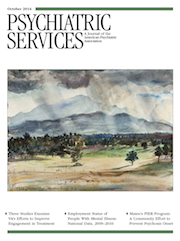Consumption of Antidepressants in Italy: Recent Trends and Their Significance for Public Health
Abstract
Objectives
The study assessed the consumption of antidepressants in Italy between 2000 and 2011 and identified trends in use.
Methods
Data on use of antidepressant drugs between 2000 and 2011 were collected from the Italian Medicines Agency database. Data were expressed as the daily defined dose (DDD) per 1,000 inhabitants. Trends in drug consumption were ascertained by logarithmic transformation of incidence rates by using the formula ln(y)=b × x, where y is the incidence rate, b is the regression coefficient, and x represents the calendar years. Time trends were expressed as expected annual percentage change (EAPC). A significance level of .05 was chosen.
Results
Antidepressant consumption increased drastically between 2000 and 2011, from 8.18 to 36.12 DDD per 1,000 inhabitants per day. A single joinpoint (time point with a significant trend change) occurred in 2002 (EAPC=56.4%, 2000–2002, and 6.2%, 2002–2011). The trend analysis stratified by type of drug showed a huge increase in consumption of selective serotonin reuptake inhibitors and other antidepressants and a decrease in consumption of tricyclic antidepressants.
Conclusions
Mental disorders are less stigmatized now than in the past. In Italy and elsewhere, antidepressant use is growing, and it would be important to monitor this trend, especially considering the possible effects of the current economic crisis on mental health. In this scenario, the role of public health in mental health promotion has become fundamental.
Depression is a common mental disease worldwide, affecting more than 350 million people of all ages (1). Suicide, related to this disorder, is a top ten cause of death in the eight regions of the world with the most advanced health transition (2). The World Health Organization (WHO) has estimated that neuropsychiatric disorders contribute to 13% of the global burden of disease and has projected that this percentage will rise to 14.7% by 2020 (3). Clearly, depression represents a relevant public health issue worldwide, given the remarkable diffusion of this illness in the population and the possible consequences in terms of disability (4).
Recent data indicate that about 21 million people in Europe (accounting for 4.5% of the total population) are affected by depression, with a cost for the health sector of around €120 billion, equivalent to 1% of the region’s gross domestic product (5).
An Italian study involving 4,712 persons reported that between 2001 and 2003, a lifetime mental disorder was experienced by one in five persons, a mental disorder in the prior year by one in 14 persons, and a mental disorder in the prior month by one in 31 persons. In addition, the risk of any mental illness was reported to be almost three times higher among women than men (6). Consequently, the consumption of neuropsychiatric drugs, such as antidepressant medication, is expected to increase in Italy, consistent with trends reported worldwide in the past decade (7–11).
Trends in antidepressant consumption are, indeed, increasing worldwide, with consumption having almost doubled or tripled during one decade in the United Kingdom, France, and other European countries as well as in the United States (7,12–14).The health expenditures for this drug category also increased (15).
Trends in use of neuropsychiatric drugs in Italy for the periods between 1955 and 2000 and between 1995 and 2003 have been previously studied. All of these analyses, however, focused on the relationships between use of antidepressant drugs and suicide rates (16–18). This study assessed the consumption of and trends in use of antidepressant drugs in Italy from 2000 to 2011.
Methods
Data collection
Openly available data on the consumption of antidepressant drugs in Italy during the 2000–2011 period were extracted from the Italian Medicines Agency (AIFA) database. The AIFA is the national public authority responsible for regulation of drugs in Italy. The AIFA promotes its activities through monitoring centers and databases, which are the essential tools through which the agency controls and analyzes drug utilization at the national, regional, and local levels.
Data on drug consumption and expenditures are presented every year in an official report by the Drug Utilization Monitoring Centre. The report contains additional information provided by the Medicines Utilization Monitoring Centre (OsMED) and is known as the OsMED report (19).
The report monitors drug prescriptions financed by the National Health Service and provides monthly reports to the regional authorities according to predefined indicators of drug consumption and expenditures. The same data are also reanalyzed by the National Observatory on Health Status in the Italian Regions, which each year publishes the “OsservaSalute Report: Health Status and Quality of the Health Assistance in the Italian Regions,” which has adopted a comparative methodology analysis and indicators that have been validated at an international level (14,19).
On the basis of the OsMED report, data were expressed as the daily defined dose (DDD) per 1,000 inhabitants and were stratified by type of drug (tricyclic antidepressants [TCAs], selective serotonin reuptake inhibitors [SSRIs], and other products). Other products included S-adenosylmethionine (ademetionine), bupropion, duloxetine, hypericum, mirtazapine, oxitriptan, reboxetine, trimipramine, trazodone, and venlafaxine. The DDD is defined as the assumed average maintenance daily dose of a drug and is approved and recommended by the WHO as a unit of measurement for drug use studies and surveys. The DDD per 1,000 inhabitants per day measures how many individuals have received a standard dose of a specific drug or of a drug category daily. This measure has been used for many years in drug consumption studies and in comparisons of drug consumption at national and international levels (20,21).
Given a DDD for a certain drug, as set by the WHO, the number of DDDs used by patients can be calculated as follows: (items issued × amount of drug per item)/DDD.
Study population
The OsMED report contains data for around 40 million Italian citizens, equal to 63% of the Italian population (demo.istat.it). The demographic characteristics of this population were representative of the whole population: 51% were women, the median age was 43 years, and 21% were older than 64 years.
Statistical analysis
Rates of consumption of antidepressants were computed as follows: [antidepressant consumption in DDD/(average population–weighted × 365)] × 1,000.
The total DDDs used (for active principle or therapeutic category) were computed by adding up all the DDDs for each prescribed treatment. In order to obtain time trends for consumption of antidepressants, we applied the following formula, which is based on Kim and colleagues’ (22) method for the logarithmic transformation of incidence rates: ln(y)=b × x, where x represents the calendar years, b is the regression coefficient, and y is the incidence rate.
In particular, a joinpoint represents the time when a significant trend change is detected. Time trends are expressed in terms of expected annual percentage change (EAPC) and respective 95% confidence intervals; the significance level of time trends is also reported. The null hypothesis was tested by identifying up to three changes in slope with an overall significance level of .05 and dividing by the number of joinpoints in the final model. Linear graphs were used to represent trends. Statistical analysis was conducted by using Joinpoint Regression Program software, version 3.5.3. To control for heteroskedasticity of the population, a Poisson model was used (23).
Results
In the year 2000, the age-weighted consumption of antidepressant drugs was equal to 8.18 DDD per 1,000 inhabitants per day. Consumption doubled to 16.24 DDD per 1,000 inhabitants per day in the following year, which started a growing and continuous trend. In 2011, the last year of the study, antidepressant consumption accounted for 36.12 DDD per 1,000 inhabitants per day.
In the first nine months of 2011, expenditures for central nervous system (CNS) drugs accounted for €17.90 per person and were ranked third among expenditures by drug category. These drugs were ranked fourth in receipt of prescriptions (58.2 DDD per 1,000 inhabitants per day) (24). Among the CNS drugs, antidepressants were prescribed the most (36.1 DDD per 1,000 inhabitants per day) and of the antidepressants, SSRIs were prescribed the most (27.5 DDD per 1,000 inhabitants per day).
Trends analysis with the joinpoint regression software found a drastic increase in consumption of antidepressants in Italy between 2000 and 2011 (from 8.18 to 36.12 DDD per 1,000 inhabitants per day). A single joinpoint was found in 2002, with a reduction of EAPC from 56.39% between 2000 and 2002 to 6.17% from 2002 to 2011 but no real inversion (Table 1). All the results were statistically significant (p≤.05). The 2000–2011 trend in consumption of antidepressant drugs is shown in Figure 1.
| Type | EAPC | 95% CI | p |
|---|---|---|---|
| All | |||
| 2000–2002 | 56.39 | 20.8 to 102.4 | <.01 |
| 2002–2011 | 6.17 | 4.7 to 7.7 | <.001 |
| TCAsb | –2.81 | –3.8 to 1.8 | <.001 |
| SSRIs | |||
| 2000–2002 | 71.12 | 27.51 to 129.60 | <.01 |
| 2002–2011 | 5.38 | 3.81 to 7.0 | <.01 |
| Other products | 13.72 | 11.51 to 15.90 | <.001 |
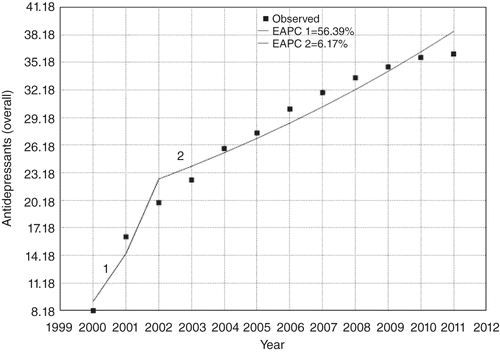
a The trend is expressed by expected annual percentage change (EAPC) in defined daily dose per 1,000 inhabitants per day. A significant trend change (joinpoint) occurred in 2002. EAPC 1 (2000–2002) and EAPC 2 (2002–2011) were statistically significant (p≤.05).
Additionally, we performed trend analyses by stratifying data by type of drug. Regarding TCAs, the data showed a reduction of consumption between 2000 and 2011, with no joinpoints (from 1.40 to 1.10 DDD per 1,000 inhabitants per day; EAPC=−2.81, p<.001) (Figure 2). Conversely, SSRIs and the other products registered a great increase over time in consumption (Figures 3 and 4). Interestingly, as was the case for the overall data, a joinpoint was shown for SSRIs in 2002 (EAPC=71.12, 2000–2002, and 5.38, 2002–2011). For the other products, the EAPC from 2000 to 2011 was 13.72, with no joinpoint. All these results were statistically significant.
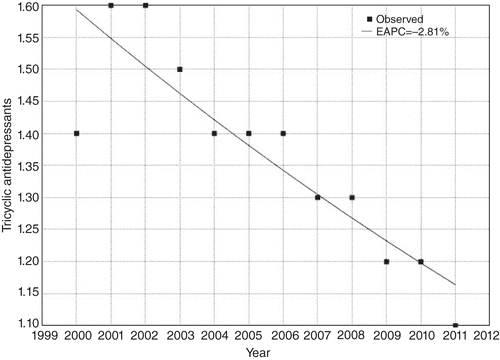
a The trend is expressed by expected annual percentage change (EAPC) in defined daily dose per 1,000 inhabitants per day. The EAPC was statistically significant (p≤.05).
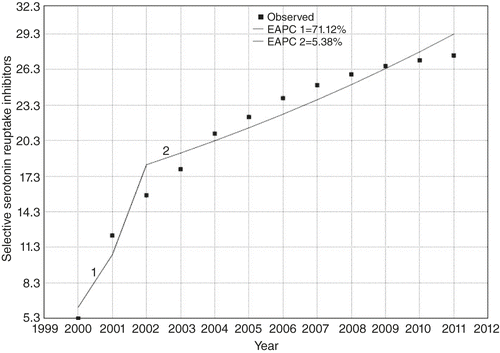
a The trend is expressed by expected annual percentage change (EAPC) in defined daily dose per 1,000 inhabitants per day. A significant trend change (joinpoint) occurred in 2002. EAPC 1 (2000–2002) and EAPC 2 (2002–2011) were statistically significant (p≤.05).
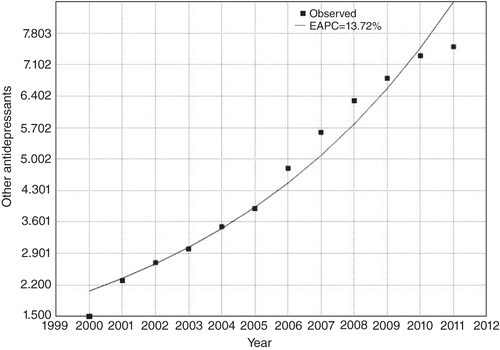
a The trend is expressed by expected annual percentage change (EAPC) in defined daily dose per 1,000 inhabitants per day. The EAPC was statistically significant (p≤.05). Other antidepressants included S-adenosylmethionine (ademetionine), bupropion, duloxetine, hypericum, mirtazapine, oxitriptan, reboxetine, trazodone, trimipramine, and venlafaxine.
Discussion
Our study assessed trends in the consumption of antidepressants in Italy from 2000 to 2011 by using the most recent data available. The results showed that consumption of antidepressants in Italy increased continuously since 2000, quadrupling by 2011. This rise in consumption affected SSRIs and the so-called other products, but not TCAs. A possible explanation for our findings is that SSRIs and the other antidepressants are largely preferred over TCAs for treatment of depression.
To date, studies of international trends indicate a huge increase in the use of antidepressants, especially after the introduction of SSRIs in the early 1990s, the publication of practice guidelines to diagnose and treat depression, and the development of efficient screening tools for depression in primary care (7,25–30). The phenomenon of high rates of depression among primary care patients is well known in the developed countries, but up to 20% of those attending primary health care in developing countries also suffer from anxiety or depressive disorders, a fact that deserves to be highlighted (31).
Notably, the increasing awareness of depression as an important health issue in the past decade has coincided with the arrival of several new classes of antidepressants that have increased the pharmacotherapy options for managing depression (32,33). These new, more expensive antidepressant drugs, which have been proven effective (34), contribute to the rise in the total cost of antidepressants (6).
However, according to a recent report by Connolly and Thase (32), none of the newer drugs have strongly addressed the unmet needs in this area of therapeutics. Small studies of ketamine, which is among the newest treatment strategies, seemed to conclude that drugs modulating glutamatergic neurotransmission may be useful for exerting rapid and large antidepressant effects among patients who have not responded to an SSRI.
Another possible explanation of our findings may be related to the increase in the Italian population, from around 57 million people in 2000 to more than 60 million in 2011, but the increase is unlikely to explain the trends completely. Additionally, the growing use of antidepressants, as Ilyas and Moncrieff (35) have suggested, may be attributed to an increase in long-term prescribing, to prescribing of antidepressants to people who are not diagnosed as having depression, and to the fact that many antidepressants have been marketed for anxiety disorders in recent years. In the United States, for example, data suggest that a majority of people with a prescription for antidepressants do not have a diagnosable mental disorder (35). Furthermore, these drugs are often prescribed by general practitioners instead of psychiatrists, especially for episodes of mild depression or anxiety and for panic attacks (14,35).
Moreover, it is important to consider that from the beginning of 2001, SSRIs have been financed by the Italian National Health Service, a fact that contributed to a huge rise in consumption.
Furthermore, the growth of direct-to-consumer marketing increases the likelihood of beginning use of antidepressants, especially when out-of-pocket medication costs are low. Conversely, it does not necessarily increase utilization levels among those already taking antidepressants (36).
Specific programs aimed at educating health professionals and patients about the correct use of these drugs can garner a huge change in future consumption, with the trend slope relatively little changed. This is a very important point for consideration by psychiatrists and public health professionals, given that implementing such programs may lead to consistent improvements in mental health and may have remarkable benefits related to expenditures by the National Health Service. Indeed, expenditures per capita for antidepressants showed a constant increase between 2010 and 2011 (.7%, SSRIs; 1.8%, other products (24). Thus the role of prevention programs to contain and reduce these expenditures becomes even more important, especially in this time of national and global economic crises.
Although there are some positive aspects to the increased consumption of antidepressants, the fourfold increase in use of these drugs between 2000 and 2011 is alarming. Thus this study seems to suggest a need for the public health agenda to address the issue of antidepressant consumption, not only in Italy but also in Europe. Interventions designed to reduce the consumption of antidepressants could include, for instance, a new regulation about off-label prescribing of these drug categories, more rigid monitoring of use of these drugs, and a public health campaign to reduce risk factors for poor mental health—for example, by reducing stress. In this regard, a meta-analysis showed that depressive symptoms can be improved by as much as 11% through specific prevention programs designed to reduce depression, such as educational interventions, lifestyle interventions, anxiety management training, and cognitive therapy (37). Consequently, providing these kinds of interventions is likely to contribute to a decrease in the consumption of drugs addressing depressive symptoms.
Surely, the limitations of this study should be considered. First, the measurement unit, DDD, is a proxy of consumption and does not necessarily reflect the real daily dose consumed. In this type of study, if the real prescribed daily dose is lower than the DDD, the use of DDD leads to an underestimation of the prevalence of use; in contrast, if the prescribed daily dose is higher than the DDD, the use of the DDD overestimates the number of patients who have a prescription for this medication. Another limitation of our study was that the AIFA database does not include drug consumption labeled as “out of pocket,” so our results refer exclusively to the consumption in the public and private settings that has an information flow monitored by the regions. In addition, reported data contained no information on compliance with therapy, and, therefore, the term “consumption” was used figuratively; at no time could we assume that the medication dispensed was actually consumed. Finally, the working group that prepared the OsservaSalute Report stratified the data by Italian region and type of drug but not by age and gender (data were not available).
Conclusions
Mental disorders, such as anxiety and depression, are less stigmatized by public opinion than they have been in the past. This change in perspective on neuropsychiatric illnesses affects compliance of drug treatment, perhaps more so because many of these drugs are often used also for the treatment of pathologies not strictly related to psychiatry, such as pain management. Thus, the implementation and monitoring of an effective flow of information are advisable, in order to easily identify the growing portion of patients who really need psychiatric treatment.
In addition, implementation of psychiatric support in the health care system, particularly in primary care, could be very useful (38). Given the global increase in the consumption of psychiatric drugs, especially antidepressants, and because good mental health is the basis of economic growth and social development in Europe, the role of public health in mental health promotion has become more and more fundamental. Moreover, the relationship between mental health problems and socioeconomic and environmental factors add to the importance of monitoring trends in use of antidepressants, especially considering the possible effects of the current economic crisis on mental health.
1 Depression. Fact sheet no 369. Geneva, World Health Organization, 2012. Available at www.who.int/mediacentre/factsheets/fs369/en. Accessed April 15, 2013Google Scholar
2 : Global and regional mortality from 235 causes of death for 20 age groups in 1990 and 2010: a systematic analysis for the Global Burden of Disease Study 2010. Lancet 380:2095–2128, 2012Crossref, Medline, Google Scholar
3 Murray CJ, Lopez AD: The Global Burden of Disease. Cambridge, Mass, Harvard School of Public Health, 1996Google Scholar
4 : Correlation between driving-related skill and alcohol use in young adults from six European countries: the TEN-D by Night Project. BMC Public Health 11:526–537, 2011Crossref, Medline, Google Scholar
5 Mental Health in OECD Countries. Paris, OECD, 2008Google Scholar
6 : Prevalence of common mental disorders in Italy: results from the European Study of the Epidemiology of Mental Disorders (ESEMeD). Social Psychiatry and Psychiatric Epidemiology 41:853–861, 2006Crossref, Medline, Google Scholar
7 : Trends in the consumption of antidepressants in Castilla y León (Spain): association between suicide rates and antidepressant drug consumption. Pharmacoepidemiology and Drug Safety 19:895–900, 2010Crossref, Medline, Google Scholar
8 : National patterns in antidepressant medication treatment. Archives of General Psychiatry 66:848–856, 2009Crossref, Medline, Google Scholar
9 : Antidepressant dispensing trends in New Zealand between 2004 and 2007. Australian and New Zealand Journal of Psychiatry 43:1131–1140, 2009Crossref, Medline, Google Scholar
10 : Antidepressant drug prescribing patterns to outpatients of an Italian local health authority during the years 1998 to 2008. Journal of Clinical Psychopharmacology 30:212–215, 2010Crossref, Medline, Google Scholar
11 : Antipsychotic prescribing trends: a review of pharmaco-epidemiological studies. Acta Psychiatrica Scandinavica 121:4–10, 2010Crossref, Medline, Google Scholar
12 Impact of Economic Crisis on Mental Health. Geneva, World Health Organization, 2011. Available at www.euro.who.int/__data/assets/pdf_file/0008/134999/e94837.pdfGoogle Scholar
13 : Antidepressants consumption in the global population in France [in French]. L'Encéphale 28:411–417, 2002Medline, Google Scholar
14 Rapporto OsservaSalute [Italian Observatory on Healthcare Report 2010]. Milan, Osservasalute, 2011. Available at www.osservasalute.itGoogle Scholar
15 : Are we going to increase the use of antidepressants up to that of benzodiazepines? European Journal of Clinical Pharmacology 60:629–634, 2004Crossref, Medline, Google Scholar
16 : Antidepressant drug use in Italy since the introduction of SSRIs: national trends, regional differences and impact on suicide rates. Social Psychiatry and Psychiatric Epidemiology 34:152–156, 1999Crossref, Medline, Google Scholar
17 : Antidepressant drug consumption and public health indicators in Italy, 1955 to 2000. Journal of Clinical Psychiatry 66:750–755, 2005Crossref, Medline, Google Scholar
18 : Suicide in Verbano-Cusio-Ossola province: decade 1990–2000 [in Italian]. Epidemiologia e Psichiatria Sociale 11:277–283, 2002Crossref, Medline, Google Scholar
19 osMED Report 2009. Rome, Italian Medicines Agency, 2009. Available at www.agenziafarmaco.gov.it/it/content/luso-dei-farmaci-italia-rapporto-osmed-2009Google Scholar
20 Guidelines for ATC Classification and DDD Assignment. Oslo, Norway, World Health Organization Collaborating Centre for Drug Statistics Methodology, 2003. Available at www.whocc.no/atc_ddd_publications/guidelinesGoogle Scholar
21 : Trends in depression diagnosis and consumption of antidepressants in Lithuania in 2004–2009. Acta Medica Lituanica 18:17–22, 2011Crossref, Google Scholar
22 : Permutation tests for joinpoint regression with applications to cancer rates. Statistics in Medicine 19:335–351, 2000Crossref, Medline, Google Scholar
23 : Hepatitis C virus infections trends in Italy, 1996–2006. Hepatitis Monthly 11:895–900, 2011Medline, Google Scholar
24 osMED Report 2011. Rome, Italian Medicines Agency, 2009. Available at www.agenziafarmaco.gov.it/it/content/luso-dei-farmaci-italia-rapporto-osmed-gennaio-settembre-2011Google Scholar
25 : Antidepressant prescribing and suicide rate in Northern Ireland. European Psychiatry 18:325–328, 2003Crossref, Medline, Google Scholar
26 : Relationship between antidepressant sales and secular trends in suicide rates in the Nordic countries. British Journal of Psychiatry 188:354–358, 2006Crossref, Medline, Google Scholar
27 : Antidepressants and public health in Iceland: time series analysis of national data. British Journal of Psychiatry 184:157–162, 2004Crossref, Medline, Google Scholar
28 : Use of psychiatric drugs in Slovenia in comparison to Scandinavian countries. Pharmacoepidemiology and Drug Safety 12:399–403, 2003Crossref, Medline, Google Scholar
29 Depression in Primary Care: Treatment of Major Depression. Pub no 93-0551. Rockville, Md, US Department of Health and Human Services; Agency for Health Care Policy and Research, 1993Google Scholar
30 : Utility of a new procedure for diagnosing mental disorders in primary care: the PRIME-MD 1,000 study. JAMA 272:1749–1756, 1994Crossref, Medline, Google Scholar
31 Gender and Women's Mental Health. Geneva, World Health Organization. Available at www.who.int/mental_health/prevention/genderwomen/en. Accessed October 1, 2013Google Scholar
32 : Emerging drugs for major depressive disorder. Expert Opinion on Emerging Drugs 17:105–126, 2012Crossref, Medline, Google Scholar
33 : Recent trends in the use of antidepressant drugs in Australia, 1990–1998. Medical Journal of Australia 173:458–461, 2000Crossref, Medline, Google Scholar
34 : Meta-analysis of selective serotonin reuptake inhibitors in patients with depression and coronary heart disease. American Journal of Cardiology 107:972–979, 2011Crossref, Medline, Google Scholar
35 : Trends in prescriptions and costs of drugs for mental disorders in England, 1998–2010. British Journal of Psychiatry 200:393–398, 2012Crossref, Medline, Google Scholar
36 : The shape of demand: what does it tell us about direct-to-consumer marketing of antidepressants? Advances in Economic Analysis and Policy 8:1805–1805, 2008Google Scholar
37 : Predictors of efficacy in depression prevention programmes: meta-analysis. British Journal of Psychiatry 183:384–397, 2003Crossref, Medline, Google Scholar
38 : Psychotherapy for depression in primary care: a panel survey of general practitioners' opinion and prescribing practice. Social Psychiatry and Psychiatric Epidemiology 49:59–68, 2013Google Scholar


